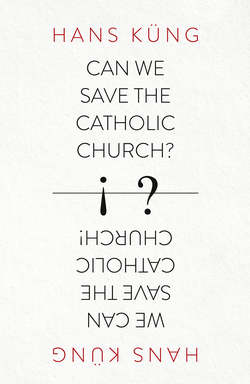Читать книгу Can We Save the Catholic Church? - Hans Kung - Страница 26
Is Tradition or Progress the Criterion of Truth?
ОглавлениеTwo opposing attitudes to the truth can be seen not only in the concerns about the physical well-being of an individual but also in the concerns regarding the welfare of a society. For one group, it is the ‘old ways’, the things that have withstood the test of time, tried-and-true knowledge that counts; in short, it is tradition that must take precedence. For the other group, it is instead what is new, up-to-date, scientific, innovative, progressive that counts. Which of them is right?
I value tradition but I am not a traditionalist. Yet, in the Church, and not just in Rome, there are people who swear by the old ways. While the ‘good old ways’ may often be a stimulus, they should never be a model per se. Such thinking assumes that God would have been present only at certain periods in the past, for example during the time of the Church Fathers (the era of patristic Greek and Latin theology and culture) or during the Middle Ages (the era of scholasticism, Romanesque and Gothic art) but would have had nothing to do with subsequent ages, in particular with the Reformation and the Enlightenment. These modern eras, the traditionalists believe, were times of ‘decline’, which they often describe in veiled, umbrella terms like ‘de-hellenization’, ‘de-churching’ (= secularization) or ‘de-Christianization’. But this approach means surrendering to the debilitating myth of decline, which is averse to any form of progress.
Along these lines, Benedict XVI saw his task as consisting primarily in preserving rather than unfolding the truth, which, for him, meant preserving tradition. But, in asserting his supreme authority over all church teachings, he claimed to determine by himself – at best with reference to his more recent predecessors – what belongs to tradition and what does not. In this vein, his predecessor Pius IX replied to the bishops who challenged his impassioned insistence on his own particular definition of papal infallibility, which claimed to rest on the Bible and tradition, with the notorious riposte: ‘La tradizione sono io’ (‘I am the tradition!’) In reality, this papal dictum represents an absolutistic understanding of truth not unlike the absolutistic understanding of the state expressed by Louis XIV’s dictum: ‘l’État – c’est moi!’
And so, in the Catholic Church of the nineteenth and twentieth century a typical Roman Catholic traditionalism or fundamentalism developed, which believed that everything should and could be left as it was – or must be restored to what it once was. That the Church continually needs to be renewed, they understand, at best, only as a moralizing truism used to discipline individual believers, for instance, in calling them to adhere more closely to papal doctrines on sexual morality and to defend the privileges of the Church. This kind of traditionalism survives into our own day. Moralizing papal platitudes are given a cheering reception by the young people at the huge youth rallies with the pope, even as these same young people continue using the pill and condoms, leaving the vestiges behind on the very grounds where the day before they had so enthusiastically cheered the pope.
Unquestioning devotion to the past results in enfeebled creativity, mental impotence and anaemic scholasticism. No, traditionalism cannot be the Church’s top priority. Rather than an unreserved commitment to some version of the past, the Church needs freedom, a freedom that also manifests itself in a critical sifting of the Church’s own history. And such a critical attitude will therefore dissociate itself from the equally extreme alternative of fanatical Modernism.
I love what is new but I am not addicted to novelty as such. In modern society, many people swear by everything that is new. They demand an unconditional orientation towards the future, setting their sights on Utopia. In the twentieth century there were those who proclaimed the advent of a 1,000-year Reich (which perished in 1945 after only 12 years); others who proclaimed the emergence of a classless society (it had run its course and collapsed by 1989). But even in the twenty-first century, many still dream of a new shape that humanity could take as a result of technological or ecological evolution, or political and social revolution. But neither black, nor brown, nor red, nor green Utopian visionaries have succeeded in bringing forth the ideal ‘new humanity’ of which they dream.
The Catholic Church has also had its share of individuals, groups and movements who were so fascinated by modern Utopias that they demanded a modernization of the Church by conforming to the spirit of the age. Alongside such modernizers, there also exists an odd Catholic mystical fanaticism paired with an apocalyptic belief in the future. The adherents of this type of apocalyptic thinking invoke higher revelations, mostly of more recent date, which go beyond those given by the historical Jesus Christ: precise prophecies about when and how the world will end, about a coming great war, about the conversion of Russia and the like, and they often underpin these prophecies with intricate numerological calculations. In his latest book, Benedict XVI himself gives an example of this kind of apocalyptic mysticism in referring to the strange ‘Secret of Fatima’. In short, these modern-day mystical prophets offer a medley of superstition and obscurantism – widely disseminated by the modern media – to satisfy the craving for miracles and religious sensationalism of people both educated and uneducated in religious teachings. But is this true Christianity? Surely not!
